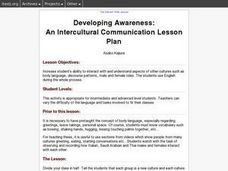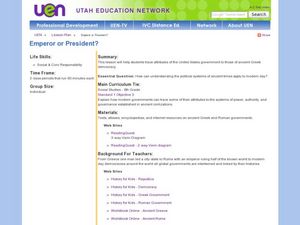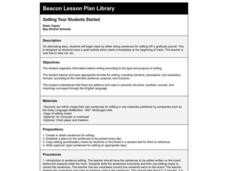Curated OER
Positive and Negative Dominoes
Students play dominoes with regular dominoes rules with some modification. Every student keep score. Every count be used--not just the 5's as in dominoes. They count outside points using white dots as positive and red dots as negatives.
Curated OER
Developing Awareness: An Intercultural Communication Lesson Plan
Students, divided into two groups, are put into a new culture, where they must create their own body language for greetings, etc. They learn aspects of other cultures such as body language, discourse patterns, male and female roles.
Curated OER
Let's Learn About Fire Safety!
In this firs safety lesson, students read Clifford , a Firehouse Dog, discuss safety rules and tips as a class, and create illustrations for the rules they generate.
Curated OER
Student Dictionary
Third graders examine the concept of alphabetizing. They develop a class dictionary, creating definitions of themselves, and typing in their names, pronunciation, and the definitions, and inserting their picture into their document.
Curated OER
Emperor or President?
Sixth graders complete a Venn Diagram. In this government comparison lesson plan, 6th graders discuss how rules are similar and different at home, school and in their community. Students learn about the type and structure of the United...
Curated OER
Getting Familiar with Fractals
Young scholars use the Internet to answer lab questions about fractals, and then construct fractals using the initial stage and iteration rule. They complete tables and generate rules for the "nth" term and create their own fractals.
Curated OER
Officer Buckle And Gloria
Students investigate the book of "Officer Buckle and Gloria" to practice the skill of reading comprehension while focusing upon finding correct traffic laws. They practice reading the story while conducting class discussion about obeying...
Curated OER
Getting Your Students Started
Third graders begin by either doing sentences for editing OR a gratitude journal. This is designed so students have a quiet activity which starts immediately at the beginning of class.
Curated OER
Why Do We Need Authority?
Students examine the problems created by a lack of effective authority described in Mark Twain's Roughing It. They explain how we use authority to protect our rights, to provide order and security, and to manage conflict.
Curated OER
What Do We Mean by "Living Things"?
Students discuss the characteristics of life. In this living things lesson students complete a lab while working in groups. Students examine different organisms and create a poster to present to the class.
Alabama Learning Exchange
Looks Like Snow
Students listen to the teacher read the book, The Jacket I Wear in the Snow, and create vocabulary and graphic cards from the story.
Curated OER
Confucius
Middle schoolers investigate the person of Confucius and his impact upon the Chinese culture. They conduct research using a variety of resources. They use the outline provided in the lesson to participate in class discussion. Key ideas...
Curated OER
Let's Go Camping!
Middle schoolers discuss the necessities for a camping trip. In this camping simulation lesson plan, students identify what supplies to take with them on a camping trip and read the rules and regulations for campers. Middle schoolers...
Curated OER
Making Informed Decisions
Students discuss various issues of importance in the 1998 congressional and gubernatorial elections, create comparison charts of their states' candidates' positions on these issues, and decide which candidate they would vote for based on...
Curated OER
Japan and The Ring of Fire
Middle schoolers engage in a study of the volcanic forces and earthquakes associated with The Ring of Fire in the Pacific Ocean. The people of Japan are researched in how they have dealt with living in the area. Also students write in...
Curated OER
A Little Kandinsky For All
Learners create abstract compositions based on the later works of Wassily Kandinsky using the primary colors in this early elementary Art lesson. The lesson emphasizes the use of color, lines, and shapes to create the abstract works of...
Curated OER
Matchstick Patterns
Third graders investigate patterns made using matchsticks and tiles, so it involves them in active studying. The relation between the number of the term of a pattern and the number of matchsticks (tiles) that that tem has is explored...
Curated OER
Balloon Powered Race Cars
Students examine Newton's Law of Motion and use the formula to calculate speed. In this laws of motion lesson students create a balloon powered car and calculate its speed and distance.
Curated OER
Small Talk Dialogues
Pupils study the rules for the use of infinitives and gerunds in written and spoken conversations. They devise a Small Talk dialogue and complete quizzes at their own rate.
Curated OER
To Tell The Truth
Learners play "To Tell The Truth" Art History style in this fun and interactive game for the upper-elementary Art classroom. Included in the activity is a detailed set of rules and suggestions for successful classroom implementation.
Curated OER
PowerPoint Ethical Dilemmas
Students watch a demonstration of a complete PowerPoint presentation discussing the ethical dilemmas using the software program. While using a storyboard, they create their own presentation and have their classmates view them. To end...
Curated OER
My Favorite Things
Pupils identify "masterpieces" and mass-produced objects. They explain why they value a given object and determine what physical materials were used to create the objects. They create a class book featuring objects that they value.
Curated OER
All About Safety
Students create a safety podcast. For this safety lesson, students in a robotics lab are introduced to the safety rules for each station. They create a podcast about one station explaining the rules with video, graphics, voice and sound...
Curated OER
Greatest Common Factor: Using the Factor Tree
Young scholars find the greatest common factor of two numbers. In this algebra lesson, students use prime factorization to find their factor to simplify equations. they create a factor tree to find the factors of composite numbers.

























